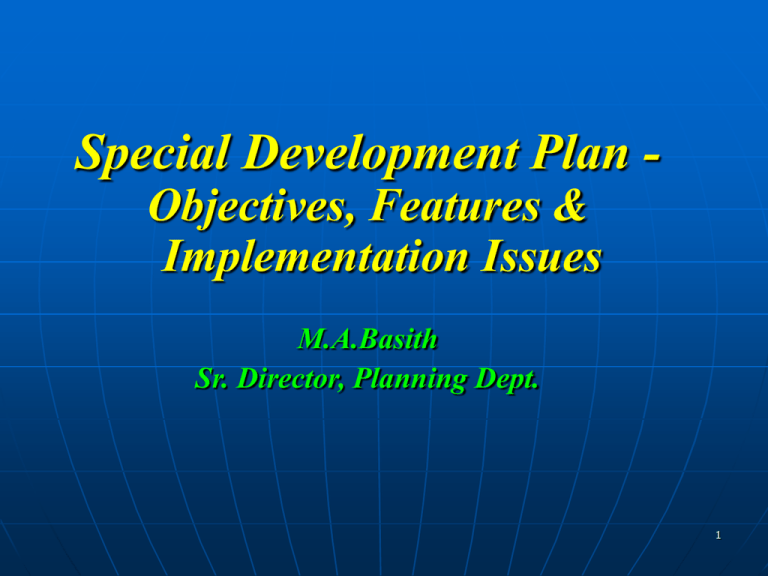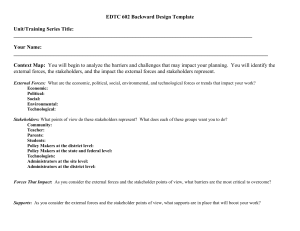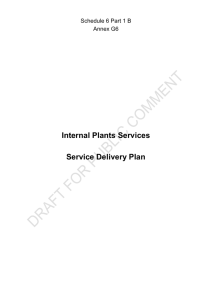Presentation on Special Development Plan by Planning Dept
advertisement

Special Development Plan Objectives, Features & Implementation Issues M.A.Basith Sr. Director, Planning Dept. 1 Background Government appointed High Power Committee for Redressal of Regional Imbalances (HPCRRI) under Dr. D.M. Nanjundappa in October 2000 HPCRRI was asked to study regional disparities existing in the State & to advise the Govt. & recommend appropriate strategies for development to minimise inter-district & interregional disparities HPCRRI was also asked to suggest an appropriate institutional mechanism for implementing the strategy for moving towards balanced development 2 Report of HPCRRI The Committee presented the Report in June 2002 The methodology adopted by the HPCRRI to measure disparity comprises a two fold approach o (a) to determine overall level of backwardness of taluk by evolving Comprehensive Composite Development Index (CCDI) using 35 indicators o (b) to consider taluks which are classified as Most Backward, More Backward and Backward Taluks The 35 indicators spread over sectors like Agriculture & Allied; Industry, Trade & Finance; Economic Infrastructure; Social Infrastructure & Population Characteristics 3 Indicators – Agriculture & Allied A1. % of Total cropped area to net area sown A2. % Area under food grains A3. % of Area under Horticultural crops to total Cropped Area A4. % Area under Commercial crops to total Cropped Area A5. % net area irrigated to net area sown A6. Fertiliser(NPK) Consumption in Kilogram per Hectare A7. No. of Tractors per 000 hectares A8. Live Stock Units per lakh rural population A9. Bank Credit to Agriculture in Rupees(000) 4 Indicators – Industry, Trade & Finance I1. No. of Industrial units per lakh population I2. % Industrial Workers to Total Main Workers I3. Bank Advances per lakh population I4. No. of Bank Branches per lakh population I5. No. of Enterprises engaged in trade,hotels & transport 5 Indicators – Economic Infrastructure E1. No. of Post Offices per lakh population E2. No. of Telephones per lakh population E3. Road length in Kms per 100 Sq.Kms E4. No. of Villages having access to all weather Roads E5. Railway line in Kms per 1000 Sq. Kms E6. No. of Motor Vehicles per lakh population E7. No. of Co-operative credit Societies per lakh population E8. Proportion of electrified villages including Hamlets E9. Regulated Markets & Sub Markets per lakh population 6 Indicators – Social Infrastructure S1. No. of Doctors per 10000 population S2. No. of Beds per 10000 population S3. Literacy Rate S4. Pupil-Teacher Rate (I to X std) S5. Children Out of School in the 6-14 age group S6. No. of Students enrolled in Aided & Degree Colleges S7. No. of Habitations having drinking water facility of 40 or more LPCD 7 Indicators – Population Characteristics P1. Sex Ratio P2. Urban Population to total Population P3. SC & ST Population P4. No. of Non Agricultural Workers P5. Agricultural labourers to Total Main Workers 8 Computation of CCDI Actual Data of Indicators was collected Data was Normalised with respect to State Average Weights at two levels are then used to arrive at CCDI for the taluk In the first level, the Normalised values are multiplied by the weight assigned to each indicator within the Sector and added In the 2nd level, these sector specific values so arrived are multiplied by weights given to the sector to arrive at CCDI 9 Classification of Taluks The taluks were classified based on the values of CCDI as follows: Taluk Most Backward More Backward Backward Relatively Devp. Total CCDI No. 0.52<CCDI<0.80 39 0.79<CCDI<0.89 40 0.88<CCDI<1.00 35 CCDI=1.00 or more 61 175 Madikeri Taluk in Kodagu District has the highest index(1.96) & Devadurga taluk in Raichur District has the lowest index (0.53) Top 10 taluks as per CCDI have only one taluk from North; whereas all the bottom 10 taluks are from North 10 Backward Taluks – Division-wise Gulbarga Belgaum Bangalore Mysore Total Most Backward More Backward Backward Total 21 5 11 2 39 5 12 13 10 40 2 28 14 31 9 33 10 22 35 114 11 Resource Allocation The Cumulative Deprivation Index(CDI), which is one minus CCDI, is calculated and added to arrive at allocation of resources, division-wise Division Gulbarga Belgaum Bangalore Mysore Total CDI 8.06 4.12 5.32 2.76 20.26 % Resource Allocation (8.06/20.26)=40 (4.12/20.26)=20 (5.32/20.26)=25 (2.76/20.26)=15 North and South Karnataka roughly get resource allocation in the ratio of 60:40 12 Recommended Outlays for 8 Years Rs. Crores Agriculture & Allied Sectors Rural Development Irrigation Power Transport(incl.Railways,Airports) Social Services Others Total 2340 7100 8000 3000 1650 8025 610 30725 13 Objectives of Special Dev. Plan A total of Rs. 30725 cr. from 2007-08, to be invested over a period of 8 years – 50 % from Normal Plan and 50 % through additional outlay Accelerate growth in backward taluks through additional investment in various sectors/areas Building infrastructure to make good the identified backlog in the backward taluks Establishing the needed institutions/organisations Providing location specific sectoral schemes in backward taluks 14 Sector-wise Allocations of SDP 2% 8% 26% 23% 5% 10% 26% Agriculture Rural Dev. Irrigation Energy Transport Social Services Others Features of Special Dev. Plan It is proposed to allocate funds in the ratio of 10%, 20%, 15%, 15%, 15%, 10%, 10% and 5% respectively in the next eight years In the 2nd and subsequent years, the allocations have been enhanced by 5% annual inflation The SDP does not take into account the recommendations already implemented and investment already made during the period June 2002 to March 2007 The current years provision is Rs. 1571.5 crores Within the allocated amount to the sector, the amount is to be distributed among the Most Backward, More Backward and Backward Taluks in the ratio of 50:30:20 A special cell to be created in Planning Dept 16 Year-wise Outlays to be Provided (Rs Crores) Year Outlay Normal Plan SDP 2007-08 1536 1536 2008-09 3226 3226 2009-10 2540 2540 2010-11 2668 2668 2011-12 2801 2801 2012-13 1961 1961 2013-14 2059 2059 2014-15 1081 1081 Total 17872 17872 Note:The figures are inclusive of 5% Annual Inflation from 2008-09 Preparation of 8-year SDP by Departments o o o o o o o o o o The implementing departments to prepare sectoral Perspective Plans for eight year period 2007-08 to 2014-15 Implementing departments to list out achievements already made as per HPCRRI Report Target Outcomes as per HPCRRI Report Measures to control Population growth in North Karnataka; No village without school Consider AP model of one medical college per district Sub-market to deal exclusively with potato, chilli etc. 20000 hectares of land under fodder cultivation Promotion of inland fisheries in Raichur & Shimoga districts All district HQs to be linked to Bangalore by air IT investments to be attracted to Hyderabad-Karnataka Thrust on girls’ hostels All tourist places to be developed in phased manner 18 Coverage of SDP The sectoral development plan should cover Normal Plan Outlay plus net additional outlays provided under SDP The departments should provide equal or more amount under Normal outlays as compared to provision under SDP The Normal outlays include : EAP, IEBR, NABARD & HUDCO assistance, ACA and also State component under CSS 19 Preparation of Annual Action Plan Each department to prepare Action Plans considering the schemes/projects as recommended in the HPCRRI Report Project profile should be prepared by departments for the additional outlays taking specific deficiencies and also the specific locations identified by the HPCRRI The departments to submit Annual Action Plans(AAPs) to Planning Dept. for approval 20 Review of SDP Planning Dept to approve AAPs and ensure their implementation as per guidelines A High Power Committee to be constituted under the chairmanship of Deputy Chairman, SPB. The Committee to conduct periodical review of implementation of SDP The implementation of SDP is to be monitored in KDP as a separate subject 21 Appraisal & Evaluation To enable each taluk to carryout a fresh appraisal of their needs and prepare taluk level plan, Planning department has created Taluk level Planning Units in 59 taluks. CEOs to ensure furnishing of taluk level data for 35 indicators for revision of CCDI In order to know the impact of investment made under SDP, the Planning department will ensure computation of taluk-wise CCDI in 2008-09, 2011-12 and 2014-15 Based on the changes noted in CCDI, Planning department will take corrective measures for resource allocation The Planning Department will carry out evaluation as required 22 Implementation Issues . . . o o PD would approve AAPs for the year 2008-09 and subsequent years contingent to the departments providing the required allocation for backward regions out of their Normal allocations. PD is preparing Templates for the departments to furnish information Some departments are provided more outlays and some depts. are provided less outlays in 2007-08 than what was required as per SDP Examples: Roads have a provision of Rs. 125 crores against Rs. 50 crores to be provided; Rural Water Supply has provision of Rs. 90 crores as against Rs. 225 crores to be provided; Urban Water Supply & Slum Improvement has no provision against Rs. 150 crores to be provided Adjustments to be made in the departments outlays in 2008-09 onwards by taking into account the provision and expenditure in the previous year/years. However, departments to ensure total provision for eight years as per SDP 23 . . . Implementation Issues On appraisal of AAPs of some department, it was noted that departments like Horticulture, Infrastructure, Water Resources & Tourism have proposed projects where resources do not flow in the ratio of 50:30:20 as the investment is either location specific or indivisible A suitable mechanism is required to ensure Region-wise expenditure to achieve 40% achievement for Gulbarga Region Earmarked Outlays as approved by PD in the AAPs are not to be diverted Monitoring mechanism is to be formulated to Monitor the works undertaken in SDP in each Sector level at taluk and Division level. 24





